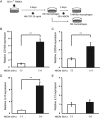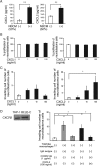Collaboration of cancer-associated fibroblasts and tumour-associated macrophages for neuroblastoma development
- PMID: 27425378
- PMCID: PMC5095779
- DOI: 10.1002/path.4769
Collaboration of cancer-associated fibroblasts and tumour-associated macrophages for neuroblastoma development
Abstract
Neuroblastoma is the most common extracranial solid tumour in children and is histologically classified by its Schwannian stromal cells. Although having fewer Schwannian stromal cells is generally associated with more aggressive phenotypes, the exact roles of other stromal cells (mainly macrophages and fibroblasts) are unclear. Here, we examined 41 cases of neuroblastoma using immunohistochemistry for the tumour-associated macrophage (TAM) markers CD68, CD163, and CD204, and a cancer-associated fibroblast (CAF) marker, alpha smooth muscle actin (αSMA). Each case was assigned to low/high groups on the basis of the number of TAMs or three groups on the basis of the αSMA-staining area for CAFs. Both the number of TAMs and the area of CAFs were significantly correlated with clinical stage, MYCN amplification, bone marrow metastasis, histological classification, histological type, and risk classification. Furthermore, TAM settled in the vicinity of the CAF area, suggesting their close interaction within the tumour microenvironment. We next determined the effects of conditioned medium of a neuroblastoma cell line (NBCM) on bone marrow-derived mesenchymal stem cells (BM-MSCs) and peripheral blood mononuclear cell (PBMC)-derived macrophages in vitro. The TAM markers CD163 and CD204 were significantly up-regulated in PBMC-derived macrophages treated with NBCM. The expression of αSMA by BM-MSCs was increased in NBCM-treated cells. Co-culturing with CAF-like BM-MSCs did not enhance the invasive ability but supported the proliferation of tumour cells, whereas tumour cells co-cultured with TAM-like macrophages had the opposite effect. Intriguingly, TAM-like macrophages enhanced not only the invasive abilities of tumour cells and BM-MSCs but also the proliferation of BM-MSCs. CXCL2 secreted from TAM-like macrophages plays an important role in tumour invasiveness. Taken together, these results indicate that PBMC-derived macrophages and BM-MSCs are recruited to a tumour site and activated into TAMs and CAFs, respectively, followed by the formation of favourable environments for neuroblastoma progression. © 2016 The Authors. The Journal of Pathology published by John Wiley & Sons Ltd on behalf of Pathological Society of Great Britain and Ireland.
Keywords: MSR1, macrophage scavenger receptor 1; cancer-associated fibroblast; neuroblastoma; tumour microenvironment; tumour-associated macrophage.
© 2016 The Authors. The Journal of Pathology published by John Wiley & Sons Ltd on behalf of Pathological Society of Great Britain and Ireland.
Figures





Comment in
-
CAFs and TAMs: maestros of the tumour microenvironment.J Pathol. 2017 Feb;241(3):313-315. doi: 10.1002/path.4824. Epub 2016 Nov 24. J Pathol. 2017. PMID: 27753093
References
-
- Modak S, Cheung NK. Neuroblastoma: therapeutic strategies for a clinical enigma. Cancer Treat Rev 2010; 36: 307–317. - PubMed
-
- Brodeur GM, Pritchard J, Berthold F, et al. Revisions of the international criteria for neuroblastoma diagnosis, staging, and response to treatment. J Clin Oncol 1993; 11: 1466–1477. - PubMed
-
- Li H, Fan X, Houghton J. Tumor microenvironment: the role of the tumor stroma in cancer. J Cell Biochem 2007; 101: 805–815. - PubMed
MeSH terms
Substances
LinkOut - more resources
Full Text Sources
Other Literature Sources
Medical
Research Materials

